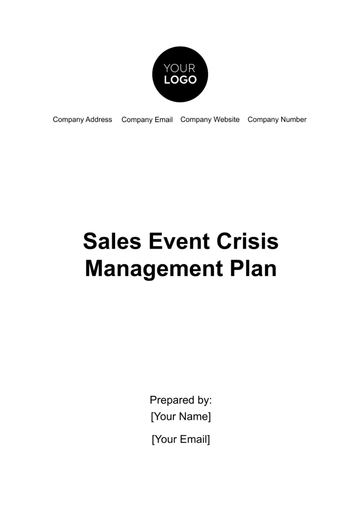Free CEO Crisis Management Plan

I. Introduction
A. Purpose of the Plan
The purpose of this CEO Crisis Management Plan is to define the strategic approach that [Your Company Name] will take in the event of a crisis. This plan ensures that the CEO and the leadership team are prepared to respond quickly, decisively, and effectively to protect the company’s operations, assets, and reputation. It outlines key roles, communication strategies, and decision-making protocols during high-pressure situations.
B. Scope of the Plan
This plan applies to all company operations globally and covers various types of crises, including financial disruptions, cyberattacks, natural disasters, and public relations issues. It provides a clear framework for the CEO’s role in leading the company through such challenges. The plan ensures that all departments and teams understand their responsibilities in a crisis context.
C. Definition of Crisis
A crisis is defined as any event or series of events that threatens to harm [Your Company Name]’s financial position, operational continuity, or public image. Crises can range from large-scale cyberattacks to unforeseen natural disasters or major product failures. Prompt identification and swift action are essential to mitigate potential long-term impacts.
D. Importance of CEO Leadership in Crisis Management
The CEO's leadership is paramount in navigating a crisis, ensuring that decisions are made quickly while maintaining a clear sense of direction. As the public face of the company, the CEO will communicate directly with stakeholders and represent the company’s values and commitment to recovery. The CEO will also maintain focus on long-term strategies for post-crisis recovery and stabilization.
II. Crisis Management Team
A. Overview of Crisis Management Team (CMT)
The Crisis Management Team (CMT) is composed of key executives from various departments who will collaborate closely to manage the crisis. The CEO will lead the team, ensuring a unified approach across all functional areas. The CMT will be activated immediately following the identification of a crisis to manage resources, communication, and decision-making.
B. Roles and Responsibilities of Key Team Members
Role | Responsibilities |
|---|---|
CEO | Oversee crisis response, make final decisions |
COO | Ensure business continuity and operational stability |
CFO | Manage financial implications and resources |
CHRO | Address employee welfare, communication, and HR policies |
CIO/CTO | Lead cybersecurity measures and IT infrastructure recovery |
Legal Counsel | Advise on legal risks, regulatory compliance, and potential lawsuits |
Communications Lead | Manage internal and external communications, press relations |
C. Communication and Coordination Among CMT Members
Coordination is critical during a crisis to ensure that all decisions are aligned with the company’s strategic goals. The CMT will communicate regularly through secure channels to assess the situation and allocate resources effectively. Weekly strategy meetings will be held during ongoing crises, with real-time updates provided as needed.
D. Crisis Response Chain of Command
The crisis response will follow a clear chain of command, with the CEO at the top making final decisions. Each department head is responsible for executing their designated crisis plans and reporting progress to the CEO. If the CEO is unavailable, the COO will assume leadership of the CMT.
III. Crisis Identification and Risk Assessment
A. Types of Crises (Financial, Operational, Legal, Reputational, etc.)
[Your Company Name] anticipates crises in the following areas:
Financial: Sudden financial downturn, loss of major client, or liquidity issues.
Operational: Breakdown in supply chain or production delays.
Legal: Regulatory fines, lawsuits, or data breaches.
Reputational: Negative media coverage or public relations scandals.
Cybersecurity: Data breaches, hacking attempts, or ransomware attacks.
B. Crisis Identification Process
Crises will be identified through internal monitoring systems, such as financial dashboards, security systems, and employee feedback channels. A crisis alert system will notify the CMT when thresholds are met (e.g., significant revenue loss, security breach). The CMT will evaluate the situation within the first 12 hours of the alert to determine the necessary course of action.
C. Crisis Prioritization
Each crisis will be prioritized based on its potential impact on the company’s operations, finances, and reputation. A severity scale (1-5) will be used, with level 1 representing minimal impact and level 5 representing catastrophic consequences. Crises with the highest severity will trigger the immediate activation of the full CMT.
IV. Crisis Communication Plan
A. Internal Communication Strategy
Internal communication will be handled via secure company channels, including emails and a dedicated crisis communication portal. Employees will receive immediate updates on their roles and the company’s actions during the crisis. A special internal FAQ page will be created to address employee concerns, ensuring transparency and minimizing misinformation.
B. External Communication Strategy
External stakeholders, including investors, media, and customers, will be kept informed through carefully crafted press releases and media interactions. The Communications Lead will manage all media inquiries and social media posts. Pre-prepared statements will be tailored to the situation, ensuring consistency and professionalism in messaging.
C. CEO's Role in Communication
The CEO will serve as the company’s primary spokesperson during a crisis. Key messages to be communicated include reassurance of the company’s recovery efforts, transparency about the crisis, and commitment to stakeholders. A public statement from the CEO will be made within the first 24 hours of a crisis, followed by periodic updates as the situation evolves.
D. Crisis Communication Templates
Templates for press releases, internal memos, and social media responses will be pre-drafted and customized for various scenarios. Sample Press Release:
Subject: [Your Company Name] Responds to Cybersecurity Incident
Key Message: "We are actively investigating a recent cybersecurity breach and are taking all necessary steps to secure our systems."
V. Decision-Making Framework
A. Establishing Clear Decision-Making Protocols
The decision-making process during a crisis will be streamlined to ensure rapid action. A decision matrix will be used to assess risk and prioritize responses. The CEO will make final calls, but key department heads will offer expertise in their respective areas to inform decisions.
B. Crisis Response Options and Scenarios
For each crisis scenario, specific response options will be outlined. Example scenarios include:
Cyberattack: Initiate IT containment, engage cybersecurity consultants, notify affected clients.
Product Recall: Contact regulatory bodies, initiate customer communication, and offer refunds or replacements.
C. Coordination with Legal and Compliance Teams
Legal counsel will provide ongoing support to ensure that all decisions comply with laws and regulations. In the case of a lawsuit or regulatory issue, they will also advise on potential liabilities. The CEO will work closely with legal experts to protect the company’s interests while mitigating the crisis’s impact.
VI. Resource Allocation and Logistics
A. Identifying Critical Resources and Personnel
The company will identify key personnel needed for crisis management and their contact information will be readily available. Critical resources such as backup data centers, emergency funds, and crisis consultants will be pre-arranged and accessible during an emergency.
B. Financial Resource Management
The CFO will create an emergency financial plan, allocating funds for crisis response. A reserve fund amounting to five million dollars is readily available for prompt utilization during emergency or crisis situations, as specified in the company's financial budget.
C. Ensuring Business Continuity
Business continuity plans will ensure that critical functions, like customer support and sales operations, remain unaffected during a crisis. The company will maintain contingency contracts with third-party providers to support operations if needed. Employees will be encouraged to work remotely when necessary to maintain productivity.
VII. Crisis Scenario Planning
A. Anticipating and Preparing for Specific Crisis Scenarios
It is essential to prepare for a range of potential crises, ensuring that the company is equipped to respond effectively. Each department will work with the CMT to create detailed action plans for various scenarios. For example:
Cybersecurity Breach | Activate cybersecurity protocols, notify affected parties, and engage with regulatory bodies for compliance. |
Natural Disasters | Ensure business continuity by securing physical assets and relocating staff to safe locations. |
Reputation Management Crisis | Immediate response via public statements and PR efforts to control the narrative and rebuild trust. |
Financial Crisis | Implement cost-cutting measures, secure additional funding, and restructure financial operations if necessary. |
B. Developing Detailed Response Plans for Each Scenario
Each crisis scenario will include step-by-step protocols that address the immediate, short-term, and long-term response. For instance, in the case of a financial crisis, the CMT will prioritize communication with investors, assess liquidity needs, and work on securing emergency capital. Simultaneously, the CFO will prepare a detailed financial recovery plan, which will be presented to the CEO for approval.
C. Testing and Simulating Crisis Scenarios
Regularly conducting crisis simulations will allow the CMT to practice response protocols and refine the plan based on lessons learned. The company will schedule quarterly tabletop exercises that simulate different crisis scenarios. These exercises will involve all key departments, ensuring that each team is prepared to execute their role in a real-life situation.
VIII. Legal and Regulatory Considerations
A. Adhering to Legal and Regulatory Requirements
Legal and regulatory compliance is a top priority during a crisis. The company will ensure that all necessary legal steps are followed, including mandatory reporting to government agencies and compliance with data protection laws. For example, in the case of a data breach, the company must notify affected individuals and regulatory bodies within 72 hours, as required by global privacy regulations.
B. Role of Legal Counsel During Crisis Response
The legal team, led by the General Counsel, will be responsible for advising on litigation risks, regulatory requirements, and other legal considerations during the crisis. They will work closely with external legal advisors to address potential lawsuits, intellectual property issues, or government inquiries.
C. Data Protection and Privacy Considerations
Legal counsel will ensure that the company complies with data privacy laws like GDPR or CCPA during a crisis. In the event of a data breach, the legal team will lead efforts to inform affected users and ensure that data protection protocols are fully followed. They will also help mitigate reputational damage by managing any legal fallout from the breach.
IX. Post-Crisis Evaluation and Recovery
A. Debriefing and Post-Crisis Assessment
Once the crisis has passed, the CMT will conduct a thorough debriefing session to evaluate the effectiveness of the crisis response. This debrief will cover what worked well, areas of improvement, and any gaps in the crisis management process. A post-crisis report will be produced, summarizing the event, response actions, and recovery steps.
B. Rebuilding Reputation and Trust
Post-crisis, rebuilding the company’s reputation will be a key focus. The CEO, along with the Communications Lead, will oversee a comprehensive strategy that includes public statements, customer outreach, and engagement with key stakeholders. The company may also consider offering compensation or other actions to customers, partners, or employees who were directly impacted by the crisis.
C. Implementing Lessons Learned
The CMT will incorporate feedback from the post-crisis review into the Crisis Management Plan, ensuring that the company is better prepared for future incidents. This may include updating protocols, adding new training modules for staff, or enhancing communication channels. An updated plan will be distributed to all employees and stakeholders, with key updates highlighted.
D. Monitoring Long-Term Impact
Even after the immediate recovery phase, [Your Company Name] will closely monitor the long-term effects of the crisis. This includes tracking financial performance, employee morale, and customer satisfaction. Regular check-ins will be scheduled to measure the progress of the recovery and ensure that the company is returning to pre-crisis performance levels.
X. Conclusion
A. The Importance of Ongoing Crisis Preparedness
Crisis management is an ongoing effort. While this plan outlines specific actions and protocols, the company will continuously review and improve its crisis response strategy based on evolving risks, technologies, and global challenges. It is critical that [Your Company Name] remain agile and ready for unforeseen events.
B. CEO’s Commitment to Crisis Management
As CEO, I am fully committed to ensuring that [Your Company Name] is prepared for any crisis that may arise. I will take an active role in overseeing the crisis management process, ensuring that all team members are equipped with the tools, resources, and support they need. The company’s resilience in times of crisis will be a testament to our leadership, commitment, and preparedness.
C. Continuous Plan Review and Updates
This Crisis Management Plan will be reviewed annually and updated as needed to reflect new risks and changing circumstances. As the business and global landscape evolve, so too must our response strategies. All employees will be informed of updates, and key training sessions will be conducted regularly to reinforce the importance of crisis preparedness across the organization.
- 100% Customizable, free editor
- Access 1 Million+ Templates, photo’s & graphics
- Download or share as a template
- Click and replace photos, graphics, text, backgrounds
- Resize, crop, AI write & more
- Access advanced editor
Efficiently manage your company’s crisis response with the CEO Crisis Management Plan Template from Template.net. This editable and customizable template allows you to tailor crisis protocols to fit your business needs. With the AI Editor Tool, you can easily modify and refine every section, ensuring a seamless and effective crisis management strategy for any situation.
You may also like
- Finance Plan
- Construction Plan
- Sales Plan
- Development Plan
- Career Plan
- Budget Plan
- HR Plan
- Education Plan
- Transition Plan
- Work Plan
- Training Plan
- Communication Plan
- Operation Plan
- Health And Safety Plan
- Strategy Plan
- Professional Development Plan
- Advertising Plan
- Risk Management Plan
- Restaurant Plan
- School Plan
- Nursing Home Patient Care Plan
- Nursing Care Plan
- Plan Event
- Startup Plan
- Social Media Plan
- Staffing Plan
- Annual Plan
- Content Plan
- Payment Plan
- Implementation Plan
- Hotel Plan
- Workout Plan
- Accounting Plan
- Campaign Plan
- Essay Plan
- 30 60 90 Day Plan
- Research Plan
- Recruitment Plan
- 90 Day Plan
- Quarterly Plan
- Emergency Plan
- 5 Year Plan
- Gym Plan
- Personal Plan
- IT and Software Plan
- Treatment Plan
- Real Estate Plan
- Law Firm Plan
- Healthcare Plan
- Improvement Plan
- Media Plan
- 5 Year Business Plan
- Learning Plan
- Marketing Campaign Plan
- Travel Agency Plan
- Cleaning Services Plan
- Interior Design Plan
- Performance Plan
- PR Plan
- Birth Plan
- Life Plan
- SEO Plan
- Disaster Recovery Plan
- Continuity Plan
- Launch Plan
- Legal Plan
- Behavior Plan
- Performance Improvement Plan
- Salon Plan
- Security Plan
- Security Management Plan
- Employee Development Plan
- Quality Plan
- Service Improvement Plan
- Growth Plan
- Incident Response Plan
- Basketball Plan
- Emergency Action Plan
- Product Launch Plan
- Spa Plan
- Employee Training Plan
- Data Analysis Plan
- Employee Action Plan
- Territory Plan
- Audit Plan
- Classroom Plan
- Activity Plan
- Parenting Plan
- Care Plan
- Project Execution Plan
- Exercise Plan
- Internship Plan
- Software Development Plan
- Continuous Improvement Plan
- Leave Plan
- 90 Day Sales Plan
- Advertising Agency Plan
- Employee Transition Plan
- Smart Action Plan
- Workplace Safety Plan
- Behavior Change Plan
- Contingency Plan
- Continuity of Operations Plan
- Health Plan
- Quality Control Plan
- Self Plan
- Sports Development Plan
- Change Management Plan
- Ecommerce Plan
- Personal Financial Plan
- Process Improvement Plan
- 30-60-90 Day Sales Plan
- Crisis Management Plan
- Engagement Plan
- Execution Plan
- Pandemic Plan
- Quality Assurance Plan
- Service Continuity Plan
- Agile Project Plan
- Fundraising Plan
- Job Transition Plan
- Asset Maintenance Plan
- Maintenance Plan
- Software Test Plan
- Staff Training and Development Plan
- 3 Year Plan
- Brand Activation Plan
- Release Plan
- Resource Plan
- Risk Mitigation Plan
- Teacher Plan
- 30 60 90 Day Plan for New Manager
- Food Safety Plan
- Food Truck Plan
- Hiring Plan
- Quality Management Plan
- Wellness Plan
- Behavior Intervention Plan
- Bonus Plan
- Investment Plan
- Maternity Leave Plan
- Pandemic Response Plan
- Succession Planning
- Coaching Plan
- Configuration Management Plan
- Remote Work Plan
- Self Care Plan
- Teaching Plan
- 100-Day Plan
- HACCP Plan
- Student Plan
- Sustainability Plan
- 30 60 90 Day Plan for Interview
- Access Plan
- Site Specific Safety Plan
























